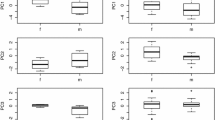Abstract
Flehmen (or “lipcurl”) is a response of male mammals primarily to female urine, performed primarily during the reproductive season. To elucidate the components of female urine that release the Flehmen, urine of black-tailed deer (Odocoileus hemionus columbianus) was fractionated, and the fractions were presented to captive male conspecifics during three rutting seasons. The active principle (one or more compounds) is watersoluble, of low volatility, not readily extractable with organic solvents, and between 200 and 12,000 daltons in molecular weight. Several urine components were identified, but none of these showed activity.
Similar content being viewed by others
References
Altieri, R.J., andMüller-Schwarze, D. 1980. Seasonal changes in Flehmen to constant urine stimuli.J. Chem. Ecol. 6:905–909.
Baxter, R.M. 1981. Flehmen in two Southern African shrew species.Mammalia 45:379–380.
Beauchamp, G.K., Wellington, J.L., Wysocki, C.J., Brand, J.G., Kubie, J.L., andSmith, A.B., III. 1980. Chemical communication in the guinea pig: Urinary components of low volatility and their access to the vomeronasal organ, pp. 327–339,in D. Müller-Schwarze and R.M. Silverstein (eds.). Chemical Signals: Vertebrates and Aquatic Invertebrates. Plenum Press, New York.
Brownlee, R.G., Silverstein, R.M., MÜller-Schwarze, D., andSinger, A.G. 1969. Isolation, identification, and function of the chief component of the male tarsal scent in blacktailed deer.Nature 221:284–285.
Estes, R.D. 1972. The role of the vomeronasal organ in mammalian reproduction.Mammalia 36:314–341.
Evans, C.S. 1980. Diosmic responses to scent-signals inLemur catta, pp. 417–420,in D. Müller-Schwarze and R.M. Silverstein (eds.). Chemical Signals: Vertebrates and Aquatic Invertebrates. Plenum Press, New York.
Gaughwin, M.D. 1979. The occurrence of Flehmen in a marsupial-the hairy-nosed wombat (Lasiorhinus latifrons).Anim. Behav. 27:1063–1065.
Henderson, J., Altieri, R., andMüller-Schwarze, D. 1980. The annual cycle of Flehmen in black-tailed deer,Odocoileus hemionus columbianus.J. Chem. Ecol. 6:537–547.
Knappe, H. 1964. Zur Funktion des Jacobsonschen Organs.Zool. Garten (NF) 28:189–194.
Ladewig, J., andHart, B.L. 1980. Flehmen and vomeronasal organ function in male goats.Physiol. Behav. 24:1067–1071.
Marchlewska-Koj, A. 1980. Partial isolation of pregnancy block pheromone in mice, pp.413–414,in D. Müller-Schwarze and R.M. Silverstein (eds.). Chemical Signals: Vertebrates and Aquatic Invertebrates. Plenum Press, New York.
Martys, M. 1977. Das Flehmen der Schweine, Suidae.Zool. Anz. 199:433–440.
Müller-Schwarze, D. 1969. Pheromone function of deer urine.Am. Zool. 9:570 (abstract).
Müller-Schwarze, D. 1971. Pheromones in black-tailed deer.Anim. Behav. 19:141–152.
Müller-Schwarze, D. 1979. Flehmen in the context of mammalian urine communication, pp. 85–86,in F.J. Ritter (ed.). Chemical Ecology: Odour communication in Animals. Elsevier/North Holland, Amsterdam.
MÜller-Schwarze, D., andAltieri, R., 1983. Flehmen behavior of black-tailed deer bucks deprived of access to female urine. In preparation.
Novotny, M., Jorgenson, J.W., Carmack, M., Wilson, S.R., Boyse, E.A., Yamazaki, K., Wilson, M., Beamer, W., andWhitten, W.K. 1980. Chemical studies of the primer mouse phermones, pp. 377–390,in D. Müller-Schwarze and R.M. Silverstein (eds.). Chemical Signals: Vertebrates and Aquatic Invertebrates. Plenum Press, New York.
Rasmussen, L.E., Schmidt, M.J., Groves, D., andDaves, G.D., Jr. 1982. Asian bull elephants: Flehmen-like responses to extractable components in female elephant estrous urine.Science 217:159–162.
Shank, C.C. 1972. Some aspects of social behavior in a population of feral goats (Capra hircus L.).Z. Tierpsychol. 30:488–528.
Schilling, A., Brouard, J.P., andGuyot, M. 1980. Preliminary chemical investigation in the olfactory interindividual discrimination of urine by a nocturnal primate,Microcebus coquereli.Olfaction Taste 7:418.
Sokolov, V.E., 1979. A species-identifying pheromone inRattus norvegicus.Dokl. Akad. Nauk USSR 248:1506.
Stahlbaum, C.C., Ekong, D.E.U., Houpt, K.A., andMeinwald, J. 1983. An investigation of the stimuli which elicit the Flehmen response of the stallion,J. Anim. Sci. 57(Suppl. 1): 125.
Wilson, M.C., Whitten, W.K., Wilson, S.R., Jorgenson, J.W., Novotny, M., andCarmack, M. 1980. Marking behavior in wild red foxes in response to synthetic volatile urinary compounds, pp 29–38,in D. Müller-Schwarze and R.M. Silverstein (eds.). Chemical Signals: Vertebrates and Aquatic Invertebrates, Plenum Press, New York.
Author information
Authors and Affiliations
Rights and permissions
About this article
Cite this article
Crump, D., Swigar, A.A., West, J.R. et al. Urine fractions that release flehmen in black-tailed deer,Odocoileus hemionus columbianus . J Chem Ecol 10, 203–215 (1984). https://doi.org/10.1007/BF00987849
Received:
Revised:
Issue Date:
DOI: https://doi.org/10.1007/BF00987849




